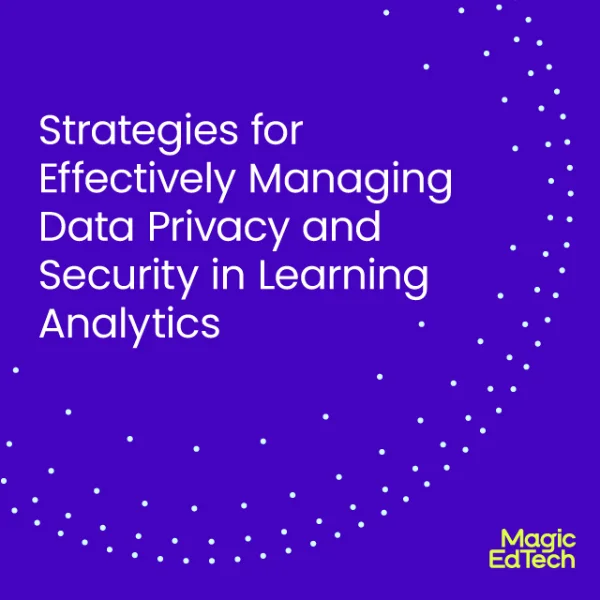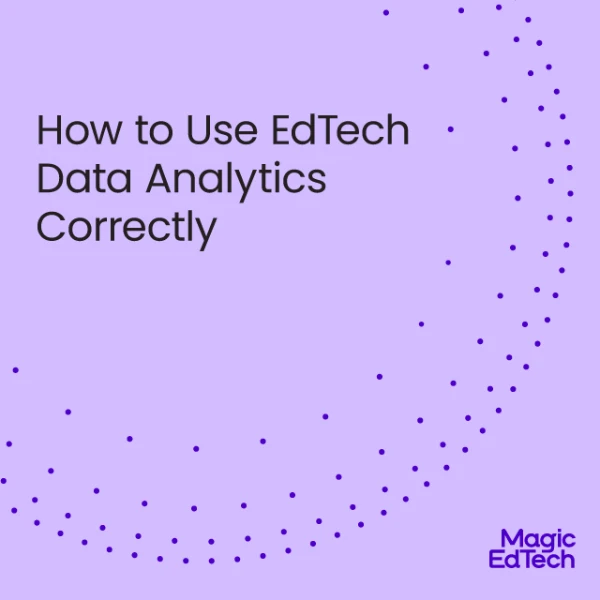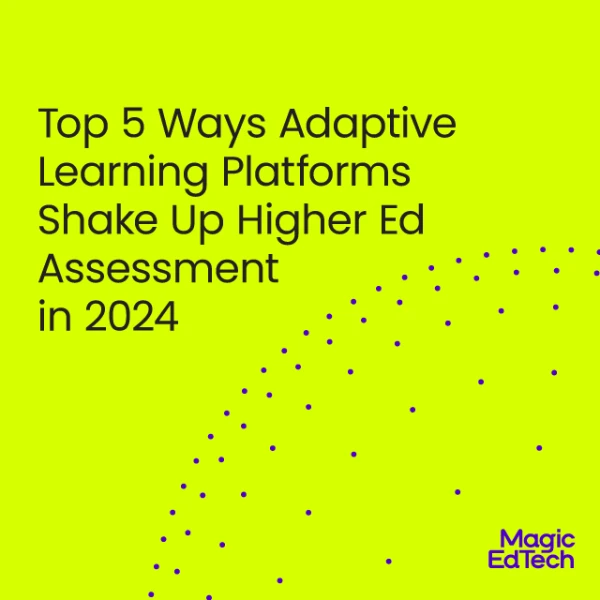Upgrade Your EdTech Game with Learning Analytics
- 22 September, 2023
- Reading Time: 5 mins
In today’s fiercely competitive landscape, who wouldn’t want to surge ahead? But here’s the catch: to thrive in this race, you need more than just ambition, you need innovation and insight.
Amidst multiple technological advancements, data analytics in EdTech is a powerful tool that can transform how educational products are developed, implemented, and improved.
This blog will cover all about learning analytics and how to leverage it to get accurate insights. We will also assess its significance, best practices, trends in 2023, engagement possibilities, and impact on education.
What Is Learning Analytics?
Let’s start with the basics. Learning analytics involves collecting, measuring, analyzing, and reporting data about learners and their contexts. It tracks various aspects of the learning process, such as student engagement, progress, and performance.
By utilizing advanced data analysis techniques, learning analytics provides actionable insights that can guide instructional decisions, curriculum enhancements, and overall educational strategies.
Data analytics assist EdTech companies in striving to create products that meet and exceed user expectations while navigating rapid technological advancements and ever-evolving educational methodologies. This pursuit requires strategic approaches that leverage data and insights to drive product innovation and user satisfaction.
The Challenges of Staying Competitive
EdTech companies face various challenges to stand out and offer remarkable learning solutions. These challenges include:
- User Expectations: Learners and educators nowadays have elevated expectations. They seek learning tools that are not only engaging but also user-friendly and practical that cater to diverse learning styles.
- Market Saturation: The EdTech market is crowded, making it difficult for companies to stand out from the crowd. With numerous players vying for attention, differentiation has become a critical factor in capturing the interest of potential users.
- Changing Educational Landscape: Educational approaches are evolving, driven by changing pedagogical approaches and learning methodologies. Hence, demanding flexibility and adaptability from EdTech solutions.
- Data-Driven Decision Making: EdTech companies need reliable data to make informed product development and enhancement decisions. Access to reliable data is indispensable for ensuring that the solutions offered meet the evolving needs of both learners and educators.
How Can Learning Analytics Help?
Learning analytics involves collecting and analyzing learner data to derive meaningful insights. By harnessing this power, EdTech companies can create better products in the following ways:
- User-Centric Design: Learning analytics uncovers user preferences and behaviors, guiding the design of products tailored to their needs.
- Feature Prioritization: Data-driven insights help prioritize features that align with users’ learning goals and preferences.
- Segmentation and Targeting: Learning analytics identifies user segments, enabling customized experiences for diverse user groups.
- Evidence-Based Decision Making: EdTech companies can make strategic decisions backed by solid data, reducing guesswork.
- Scalability and Adaptability: Learning analytics reveals usage patterns, aiding in scaling products and adapting them to changing needs.
- Pricing and Business Models: Data-driven insights inform pricing strategies, ensuring value while remaining competitive.
While the potential of learning analytics is vast, ethical considerations loom large. Transparency emerges as a fundamental principle, where users have the right to full awareness regarding the data collected and its intended usage. This transparency empowers users and lays the foundation for trust in the EdTech ecosystem.
Moreover, the significance of explicit consent cannot be overstated. EdTech companies should prioritize obtaining informed consent from users before any data collection occurs, respecting individual privacy choices and reinforcing a sense of control over personal information. Stringent measures for data privacy, including robust security and anonymization protocols, are vital in safeguarding learner data and ensuring that sensitive information remains confidential and protected. EdTech companies need to strike a balance between the transformative potential of learning analytics while upholding the values of transparency, consent, and data privacy.
How Does Learning Analytics in Education Impact Your Product Strategy?
Product analytics for education has a far-reaching impact on EdTech companies. It has emerged as a transformative force in education, shaping how educators, institutions, and Education Analytics enable EdTech companies to approach their work more effectively. Its effect is far-reaching, influencing various aspects of the product creation strategies. These include:
Informed Decision-Making
Learning analytics equips educators and administrators with data-driven insights to make informed decisions. You can tailor your teaching strategies to meet individual needs by analyzing student performance, engagement, and progress.
These insights guide curriculum adjustments, resource allocation, and instructional approaches, ensuring a more effective and targeted educational experience.
Continuous Improvement
Learning analytics promotes a culture of continuous improvement. By tracking and analyzing data, you can iterate and refine your teaching methods over time. This iterative approach allows you to identify what works best for your students and make necessary adjustments to enhance their learning experiences continually.
Research and Innovation
Learning analytics generates valuable data for educational research and innovation. The insights from student interactions and performance trends contribute to a broader understanding of effective teaching and learning strategies.
This data-driven research informs the development of new pedagogical approaches and innovative educational technologies.
Data-Driven Collaboration
Educational institutions and EdTech companies benefit from collaborative insights made possible by learning analytics. By sharing data and analysis, stakeholders can collaboratively develop strategies that align with broader educational goals. This collaborative approach enhances the effectiveness of educational products and services.
Time Efficiency
Learning analytics streamlines your work by providing efficient methods for monitoring student progress. Automated data collection and analysis reduce manual tracking efforts, allowing you to allocate more time to instructional planning and student interaction.
What Are the Top Learning Analytics Trends?
With continuous innovations, you can expect several key trends to shape the learning analytics landscape. Let’s take a look at them in the following points.
- AI and Machine Learning Integration: AI and Machine Learning enhance learning analytics by enabling accurate predictions and personalized insights. These algorithms identify patterns in student behavior, tailoring instructional approaches.
- Microlearning Analytics: Microlearning gains traction as an effective strategy. Analytics provide detailed insights into student engagement with bite-sized content, optimizing modules for preferences.
- Predictive Analytics for Adaptive Learning: Predictive analytics forecasts future trends, particularly in adaptive learning. By analyzing historical data, educators design tailored learning experiences.
- Gamification Analytics: Gamification analytics enhances engagement by assessing how elements like badges impact motivation. Insights guide effective gamification strategies.
- Social Learning Insights: Understanding social learning dynamics is critical. Analyzing group interactions informs collaboration strategies, fostering effective peer-to-peer learning.
- Learning Path Optimization: Analytics optimize learning paths. Individual progress tracking identifies gaps, allowing for personalized support and resource adjustments.
- Integration of Multimodal Data: Learning analytics evolve with diverse data. Multimodal integration includes video, speech, and sensor data, providing comprehensive insights.
Final Thoughts
In EdTech, learning analytics is the way to enhance your product strategies and create an impact. Leveraging the power of data, educators and EdTech companies can collaborate to create more effective, engaging, and personalized learning experiences. As we move forward, the integration of learning analytics will continue to shape the future of education, improving outcomes and empowering learners across the globe.
Are you curious to explore the depths of learning analytics? Experts at Magic EdTech specialize in crafting strategies that utilize the power of learning analytics to create exceptional EdTech products.
Visit our website to learn more about our expertise, services, and success stories, or schedule a call with the Magic EdTech team today!





